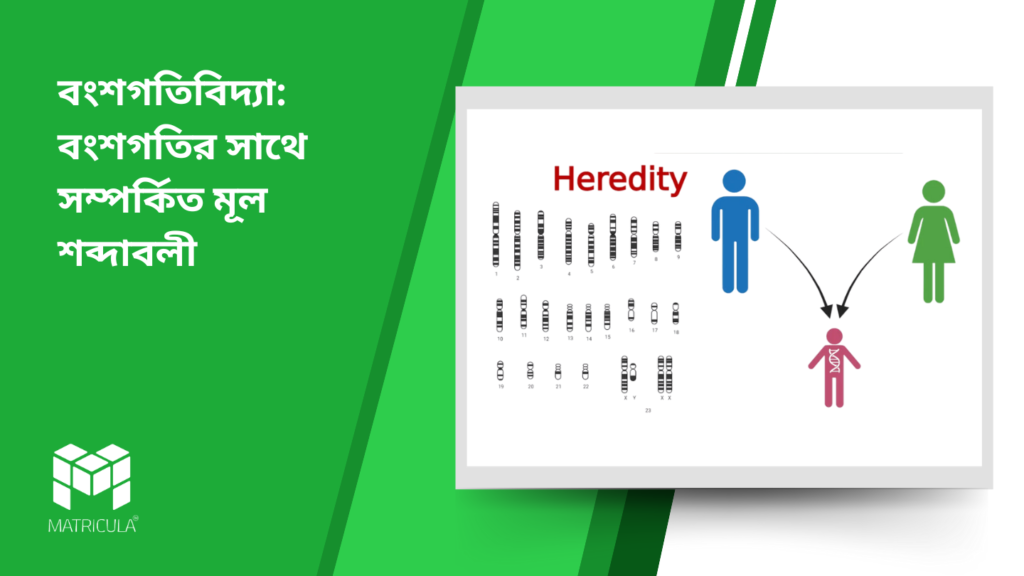Introduction
Heredity is the process by which traits are passed from parents to offspring through genetic material. This process follows specific principles that were first studied by Gregor Mendel. To understand heredity better, it is essential to be familiar with key terms associated with genetics. This article provides an in-depth explanation of important genetic concepts that form the foundation of heredity.
1. Characteristics or Traits
A characteristic is a distinguishing feature of an organism, while a trait is a specific variation of that characteristic. For example, eye color is a characteristic, while having blue or brown eyes is a trait. Traits are inherited from parents through genes and can be influenced by both genetic and environmental factors.
2. Allele
An allele is a variant form of a gene. Every gene exists in pairs, and each pair contains two alleles—one inherited from the mother and the other from the father. These alleles can be identical or different, influencing how a trait is expressed. For example, the gene for flower color in pea plants has two alleles: one for purple flowers and another for white flowers.
3. Unit of Inheritance Factor
The unit of inheritance refers to genes, which carry hereditary information. Mendel initially described these as factors before they were later recognized as genes. Genes are located on chromosomes and are responsible for passing genetic traits from one generation to another.
4. Locus
The locus (plural: loci) is the specific location of a gene on a chromosome. Each gene occupies a fixed position on a chromosome, which determines its inheritance pattern. Identical genes found at the same locus on homologous chromosomes can have different alleles, leading to variations in traits.
5. Monohybrid and Dihybrid Cross
A monohybrid cross is a genetic cross that involves a single trait. It is used to study the inheritance pattern of one characteristic, such as plant height (tall or short).
A dihybrid cross, on the other hand, examines the inheritance of two different traits simultaneously, such as flower color and seed shape in pea plants. Mendel’s dihybrid cross experiment led to the discovery of the law of independent assortment, which explains how different genes are inherited independently.
6. Homozygous and Heterozygous Organisms
An organism is homozygous for a trait if it carries two identical alleles for a gene (e.g., TT for tall plants or tt for short plants).
A heterozygous organism has two different alleles for a gene (e.g., Tt). In this case, the dominant allele expresses itself, masking the effect of the recessive allele.
7. Hybridization
Hybridization is the process of crossing two genetically different individuals to produce offspring with desired traits. This method is commonly used in agriculture and animal breeding to improve characteristics like disease resistance, growth rate, and productivity.
8. Pure and Hybrid
A pure organism is one that has been bred over multiple generations to ensure genetic uniformity, meaning it has homozygous alleles (e.g., TT or tt).
A hybrid organism results from the crossbreeding of two genetically different individuals, usually carrying heterozygous alleles (Tt). Hybrids often show improved traits due to the phenomenon of hybrid vigor or heterosis.
9. Parental Generation (P Generation)
The parental generation (P generation) refers to the first set of individuals used in a genetic cross. These individuals are typically purebred (homozygous) for the traits being studied.
10. Filial Generation (F1 and F2 Generations)
The first filial generation (F1 generation) consists of the offspring resulting from the parental cross. These offspring typically exhibit dominant traits.
The second filial generation (F2 generation) arises when F1 individuals are crossed among themselves. This generation reveals both dominant and recessive traits in a predictable ratio, as demonstrated by Mendel’s pea plant experiments.
11. Dominant and Recessive Characteristics
A dominant trait is one that is expressed in a heterozygous individual (Tt). It masks the effect of the recessive allele. For example, in pea plants, tall height (T) is dominant over short height (t).
A recessive trait is only expressed when both alleles are recessive (tt). If a dominant allele is present, the recessive trait remains hidden.
12. Phenotype and Genotype
The phenotype refers to the observable physical characteristics of an organism, such as flower color, height, or eye color. It is influenced by both genetics and environmental factors.
The genotype is the genetic makeup of an organism, represented by allele combinations (e.g., TT, Tt, or tt). While the genotype determines the potential traits of an organism, only the dominant ones may be visible in the phenotype.
Understanding these key terms is crucial for grasping the principles of heredity. The study of genetics helps scientists predict inheritance patterns, improve crop production, and even treat genetic disorders. By learning these fundamental concepts, students can build a strong foundation in biology and explore the fascinating world of genetics.
বংশগতিবিদ্যা: বংশগতির সাথে সম্পর্কিত মূল শব্দাবলী
ভূমিকা
বংশগতিবিদ্যা হল সেই প্রক্রিয়া যার মাধ্যমে জিনগত উপাদান পিতা-মাতা থেকে সন্তানের মধ্যে সঞ্চারিত হয়। গ্রেগর মেন্ডেল সর্বপ্রথম এই প্রক্রিয়ার ভিত্তি স্থাপন করেন। বংশগতির ধারণা ভালোভাবে বোঝার জন্য কিছু গুরুত্বপূর্ণ জিনগত শব্দ সম্পর্কে জানা প্রয়োজন। এই প্রবন্ধে বংশগতির সাথে সম্পর্কিত মূল শব্দগুলোর বিস্তারিত ব্যাখ্যা দেওয়া হয়েছে।
১. বৈশিষ্ট্য বা গুণ
বৈশিষ্ট্য হল একটি জীবের স্বতন্ত্র বৈশিষ্ট্য, আর গুণ হল ওই বৈশিষ্ট্যের নির্দিষ্ট রূপ। যেমন, চোখের রঙ একটি বৈশিষ্ট্য, আর নীল বা বাদামী চোখ গুণ। এই গুণাবলী জিনের মাধ্যমে বংশ পরম্পরায় সঞ্চারিত হয় এবং পরিবেশগত কারণেও প্রভাবিত হতে পারে।
২. অ্যালিল (Allele)
অ্যালিল হল কোনো নির্দিষ্ট জিনের বিভিন্ন রূপ। প্রতিটি জিনের দুটি অ্যালিল থাকে—একটি মা থেকে এবং অন্যটি বাবা থেকে আসে। এই অ্যালিলগুলো একরকম বা ভিন্ন হতে পারে এবং এগুলো নির্ধারণ করে জীবের নির্দিষ্ট গুণ। যেমন, মটর গাছের ফুলের রঙ নির্ধারণকারী জিনের দুটি অ্যালিল থাকতে পারে—একটি বেগুনি রঙের জন্য এবং অন্যটি সাদা রঙের জন্য।
৩. বংশগতির একক (Unit of Inheritance Factor)
বংশগতির একক হল জিন, যা বংশগত তথ্য বহন করে। গ্রেগর মেন্ডেল প্রথমে এগুলোকে ফ্যাক্টর বা উপাদান হিসেবে উল্লেখ করেছিলেন, যা পরে জিন নামে পরিচিত হয়। জিন ক্রোমোজোমের মধ্যে অবস্থিত এবং এটি বংশগত বৈশিষ্ট্য প্রজন্মের পর প্রজন্ম বহন করে।
৪. লোকাস (Locus)
লোকাস হল ক্রোমোজোমে কোনো নির্দিষ্ট জিনের অবস্থান। প্রতিটি জিন একটি নির্দিষ্ট লোকাসে অবস্থান করে, যা তার বংশগতির ধরণ নির্ধারণ করে। একই লোকাসে অবস্থিত দুটি অ্যালিল ভিন্ন হতে পারে, যার ফলে জীবের বৈশিষ্ট্যের পার্থক্য সৃষ্টি হয়।
৫. মনোহাইব্রিড এবং ডাইহাইব্রিড ক্রস
একটি মনোহাইব্রিড ক্রস হল এমন একটি বংশগত পরীক্ষা যেখানে মাত্র একটি বৈশিষ্ট্য নিয়ে গবেষণা করা হয়। যেমন, উদ্ভিদের উচ্চতা (লম্বা বা ছোট) নিয়ে গবেষণা করা।
একটি ডাইহাইব্রিড ক্রস দুটি ভিন্ন বৈশিষ্ট্যের উত্তরাধিকার কেমন হয় তা বোঝার জন্য ব্যবহৃত হয়। যেমন, মটর গাছের ক্ষেত্রে ফুলের রঙ এবং বীজের আকৃতির উপর গবেষণা করা। মেন্ডেলের ডাইহাইব্রিড ক্রস পরীক্ষার মাধ্যমে স্বাধীন সংযোজনের সূত্র (Law of Independent Assortment) আবিষ্কৃত হয়, যা বলে যে ভিন্ন ভিন্ন জিন পরস্পরের থেকে স্বাধীনভাবে উত্তরাধিকার লাভ করে।
৬. হোমোজাইগাস এবং হেটেরোজাইগাস জীব
যদি কোনো জীবের একটি নির্দিষ্ট বৈশিষ্ট্যের জন্য দুইটি অভিন্ন অ্যালিল থাকে (যেমন, TT বা tt), তাহলে তাকে হোমোজাইগাস বলা হয়।
যদি কোনো জীবের দুটি ভিন্ন অ্যালিল থাকে (যেমন, Tt), তাহলে তাকে হেটেরোজাইগাস বলা হয়। এই ক্ষেত্রে, প্রভাবশালী (Dominant) অ্যালিলের বৈশিষ্ট্য প্রকাশ পায় এবং দুর্বল (Recessive) অ্যালিলের বৈশিষ্ট্য চাপা পড়ে যায়।
৭. সংকরায়ন (Hybridization)
সংকরায়ন হল দুটি ভিন্ন জিনগত বৈশিষ্ট্যের জীবকে পরস্পরের সাথে সংকরিত করে নতুন বৈশিষ্ট্যযুক্ত সন্তান উৎপাদনের প্রক্রিয়া। এটি কৃষি ও পশুপালনের ক্ষেত্রে বহুল ব্যবহৃত হয়, যেমন অধিক ফলনশীল ফসল বা রোগ প্রতিরোধী প্রাণী উৎপাদনে।
৮. বিশুদ্ধ (Pure) এবং সংকর (Hybrid)
একটি বিশুদ্ধ জীব এমন এক জীব যা দীর্ঘকাল ধরে একই বৈশিষ্ট্যের জন্য নির্বাচিত ও প্রজনিত হয়েছে, অর্থাৎ এটি হোমোজাইগাস (TT বা tt)।
একটি সংকর জীব হল দুটি ভিন্ন জিনগত বৈশিষ্ট্যযুক্ত জীবের মধ্যে সংকরায়নের ফলে উৎপন্ন জীব, যা সাধারণত হেটেরোজাইগাস (Tt) হয়। সংকর জীবের ক্ষেত্রে সংকর বল (Hybrid Vigor) দেখা যায়, যার ফলে তাদের বৃদ্ধি ও উৎপাদনশীলতা বেশি হয়।
৯. পিতৃপ্রজন্ম (Parental Generation – P Generation)
পিতৃপ্রজন্ম (P Generation) হল সেই জীবগুচ্ছ, যাদের মধ্যে ক্রস-ব্রিডিং বা সংকরায়ন করা হয়। সাধারণত, এই প্রজন্মের জীবেরা বিশুদ্ধ জাতের হয় (হোমোজাইগাস)।
১০. ফিলিয়াল প্রজন্ম (Filial Generation – F1 এবং F2 প্রজন্ম)
প্রথম ফিলিয়াল প্রজন্ম (F1 Generation) হল পিতৃপ্রজন্মের ক্রসের ফলে উৎপন্ন প্রথম প্রজন্মের সন্তান। এই প্রজন্মে সাধারণত প্রভাবশালী বৈশিষ্ট্য দেখা যায়।
দ্বিতীয় ফিলিয়াল প্রজন্ম (F2 Generation) হল F1 প্রজন্মের মধ্যে সংকরায়নের ফলে উৎপন্ন প্রজন্ম। এই প্রজন্মে প্রভাবশালী ও দুর্বল উভয় বৈশিষ্ট্য নির্দিষ্ট অনুপাতে প্রকাশ পায়, যেমন মেন্ডেলের মটর গাছ পরীক্ষায় দেখা গেছে।
১১. প্রভাবশালী এবং দুর্বল বৈশিষ্ট্য
একটি প্রভাবশালী বৈশিষ্ট্য হল এমন একটি বৈশিষ্ট্য যা হেটেরোজাইগাস অবস্থায় (Tt) প্রকাশ পায় এবং দুর্বল বৈশিষ্ট্যকে ঢেকে ফেলে। যেমন, মটর গাছে লম্বা উচ্চতা (T) ছোট উচ্চতার (t) তুলনায় প্রভাবশালী।
একটি দুর্বল বৈশিষ্ট্য তখনই প্রকাশ পায় যখন দুটি দুর্বল অ্যালিল (tt) একত্রে উপস্থিত থাকে। যদি একটি প্রভাবশালী অ্যালিল থাকে, তবে দুর্বল বৈশিষ্ট্য প্রকাশ পাবে না।
১২. বাহ্যিক ও অন্তর্নিহিত বৈশিষ্ট্য (Phenotype এবং Genotype)
বাহ্যিক বৈশিষ্ট্য (Phenotype) হল জীবের দৃশ্যমান বৈশিষ্ট্য, যেমন গাছের উচ্চতা, ফুলের রঙ, চোখের রঙ ইত্যাদি। এটি জিনগত উপাদান ও পরিবেশগত প্রভাবের সংমিশ্রণে গঠিত হয়।
অন্তর্নিহিত বৈশিষ্ট্য (Genotype) হল জীবের জিনগত গঠন, যা অ্যালিলের সংমিশ্রণ দ্বারা প্রকাশিত হয় (যেমন, TT, Tt, বা tt)। যদিও জিনোটাইপ জীবের প্রকৃত জিনগত উপাদান নির্দেশ করে, বাহ্যিকভাবে শুধুমাত্র প্রভাবশালী বৈশিষ্ট্য দৃশ্যমান হয়।
উপসংহার
এই মূল শব্দগুলো বংশগতিবিদ্যার মৌলিক ধারণাগুলি বুঝতে সাহায্য করে। জিনগত গবেষণার মাধ্যমে বিজ্ঞানীরা উত্তরাধিকার সূত্রে বৈশিষ্ট্য কিভাবে স্থানান্তরিত হয় তা বোঝার চেষ্টা করেন, কৃষি উন্নয়নে সহায়তা করেন, এমনকি জিনগত রোগের চিকিৎসার পথ খোঁজেন। এই ধারণাগুলি বোঝার মাধ্যমে শিক্ষার্থীরা জীববিদ্যার জগতে আরও গভীরভাবে প্রবেশ করতে পারবে এবং বংশগতির বিস্ময়কর জগৎ সম্পর্কে জানার সুযোগ পাবে।




